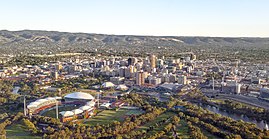| Adelaide City Centre Tarndanya Adelaide, South Australia | |||||||||||||||
|---|---|---|---|---|---|---|---|---|---|---|---|---|---|---|---|
 Adelaide City Centre with Adelaide Oval and the Adelaide Festival Centre in view (2015) | |||||||||||||||
 | |||||||||||||||
| Population | 18,202 (SAL 2021)[1] | ||||||||||||||
| Established | 1837 | ||||||||||||||
| Postcode(s) | 5000 | ||||||||||||||
| Area | 10.5 km2 (4.1 sq mi) | ||||||||||||||
| Location |
| ||||||||||||||
| Region | Eastern Adelaide[2] | ||||||||||||||
| State electorate(s) | Adelaide | ||||||||||||||
| Federal division(s) | Adelaide | ||||||||||||||
| |||||||||||||||
Adelaide city centre (Kaurna: Tarndanya)[5] is the inner city locality of Greater Adelaide, the capital city of South Australia. It is known by locals simply as "the City" or "Town" to distinguish it from Greater Adelaide and from the City of Adelaide local government area (which also includes North Adelaide and from the Park Lands around the whole city centre). The residential population was 18,202 in the 2021 census, with a local worker population of 130,404.[6]
Adelaide city centre was planned in 1837 on a greenfield site following a grid layout, with streets running at right angles to each other. It covers an area of 4.33 square kilometres (1.67 square miles) and is surrounded by 6.68 square kilometres (2.58 square miles) of park lands.[7][note 1] Within the city are five parks: Victoria Square in the exact centre and four other, smaller parks.
Names for elements of the city centre are as follows:
- The "city square mile" (in reality 1.67 square miles or 4.33 square kilometres) is the constructed area bordered by North, East, South and West Terraces.
- The "central business district" (CBD) is an alternative term, but more accurately describes the intensively developed northern half of the city, which contains a multitude of commercial, cultural and entertainment premises, restaurants and high-rise apartments. The southern, lower-density half mainly contains small businesses, restaurants and, residentially, a mix of mansions, houses and conserved 19th century cottages, and (fewer) high-rise apartments.
- Precincts such as the West End and the East End have distinctive characters. CBD shopping precincts include Rundle Mall and Adelaide Central Market.
- In what is often described as the "North Terrace cultural precinct", many educational, cultural, entertainment and medical institutions lie between the northern side of North Terrace and the River Torrens – notably university campuses, the Adelaide Festival Centre, and the Parliament of South Australia. Adelaide railway station is also located there.
- ^ Australian Bureau of Statistics (28 June 2022). "Adelaide (suburb and locality)". Australian Census 2021 QuickStats. Retrieved 28 June 2022.
- ^ "Eastern Adelaide SA Government region" (PDF). The Government of South Australia. Archived (PDF) from the original on 27 March 2019. Retrieved 17 April 2017.
- ^ Australian Bureau of Statistics (27 June 2017). "Adelaide (State Suburb)". 2016 Census QuickStats. Retrieved 23 November 2017.
- ^ Australian Bureau of Statistics (31 October 2012). "Adelaide (State Suburb)". 2011 Census QuickStats. Retrieved 25 January 2015.
- ^ "Kaurna Place Names". kaurnaplacenames.com. Retrieved 15 September 2022.
- ^ "Local workers statistics | Adelaide | economy.id".
- ^ Data from Google Earth.
Cite error: There are <ref group=note> tags on this page, but the references will not show without a {{reflist|group=note}} template (see the help page).
